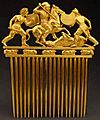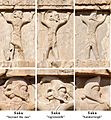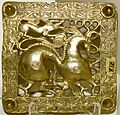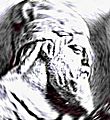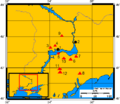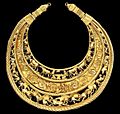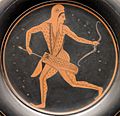Scythians facts for kids

Approximate extent of East Iranian languages the 1st century BC is shown in orange.
|
|
| Total population | |
|---|---|
| Unknown | |
| Regions with significant populations | |
| Eastern Europe Central Asia West Asia Northern India |
|
| Languages | |
| Scythian language | |
| Religion | |
| Animism, Buddhism, Hinduism and Zoroastrianism | |
| Related ethnic groups | |
The Scythians or Scyths. were Iranian nomadic Eurasian people.
They were nomadic, famous for their skills at horse riding, who dominated the Pontic steppe (modern Ukraine and Southern Russia) throughout the ancient world. By the 2nd century AD the closely-related Sarmatians came to dominate the Scyths in this area. Much of our information about the Scyths comes from the famous Greek historian Herodotus (c. 440 BC) in his Histories, and from archaeologically from the beautiful goldwork found in Scythian kurgan burial mounds in Ukraine and southern Russia.
Images for kids
-
Scythian vessel from Voronezh, 4th century BCE. Hermitage Museum.
-
For the Achaemenids, there were three types of Sakas: the Sakā tayai paradraya ("beyond the sea", presumably between the Greeks and the Thracians on the Western side of the Black Sea), the Sakā tigraxaudā ("with pointed caps"), the Sakā haumavargā ("Hauma drinkers", furthest East). Soldiers of the Achaemenid army, Xerxes I tomb detail, circa 480 BCE.
-
Gold Scythian belt title, Mingachevir (ancient Scythian kingdom), Azerbaijan, 7th century BCE
-
The territory of the Scythae Basilaei ("Royal Scyths") along the north shore of the Black Sea around 125 AD
-
Arzhan kurgan in Tuva Republic, southern Siberia, Russia
-
Remains of Scythian Neapolis near modern-day Simferopol, Crimea. It served as a political center of the Scythians in the Late Scythian period.
-
Gold pectoral, or neckpiece, from a royal kurgan in Tovsta Mohyla, Pokrov, Ukraine, dated to the second half of the 4th century BCE, of Greek workmanship. The central lower tier shows three horses, each being torn apart by two griffins. Scythian art was especially focused on animal figures.
-
An Attic vase-painting of a Scythian archer (a police force in Athens) by Epiktetos, 520–500 BCE
-
Scythians at the Tomb of Ovid (c. 1640), by Johann Heinrich Schönfeld
-
Romantic nationalism: Battle between the Scythians and the Slavs (Viktor Vasnetsov, 1881)
-
Eugène Delacroix's painting of the Roman poet, Ovid, in exile among the Scythians
See also
 In Spanish: Pueblos escitas para niños
In Spanish: Pueblos escitas para niños


